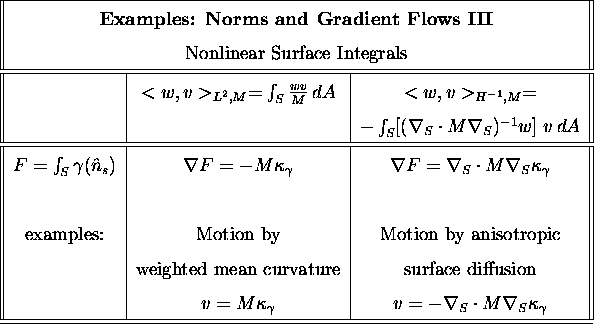Interfacial motion arises in two different ways: 1) as the motion of two-dimensional level sets during gradient flow of an integral over volume; 2) as a velocity normal to a surface, where the velocity is gradient flow of a surface integral. The first method is discussed in Section 3.2.1.
The second approach has been discussed above and appears in tables I and in table II
in small slope approximation and as the graph of a function z(x,y), respectively, for
isotropic surfaces.
For anisotropic surfaces, the energy functional is a surface integral:
![]() .
The interfacial surface energy density,
.
The interfacial surface energy density, ![]() , does not necessarily
have continuous derivatives of the surface orientation
, does not necessarily
have continuous derivatives of the surface orientation ![]() ; in fact,
; in fact, ![]() need not be continuous.
Furthermore, the surface S can have edges and corners where its derivatives are discontinuous;
furthermore it can have flat facets.
In this case, the variational derivative is the instantaneous increase in interfacial area due
to a normal velocity v, weighted by the surface energy density, and is called the `weighted
mean curvature'
need not be continuous.
Furthermore, the surface S can have edges and corners where its derivatives are discontinuous;
furthermore it can have flat facets.
In this case, the variational derivative is the instantaneous increase in interfacial area due
to a normal velocity v, weighted by the surface energy density, and is called the `weighted
mean curvature' ![]() [6].
When
[6].
When ![]() is isotropic,
is isotropic, ![]() is equal to
is equal to ![]() ,
where
,
where ![]() is the geometric mean curvature.
In two dimensions,
is the geometric mean curvature.
In two dimensions, ![]() , when
, when ![]() is
twice differentiable with respect to the polar angle
is
twice differentiable with respect to the polar angle ![]() , which is the the Herring
formulation[7].
Generally,
, which is the the Herring
formulation[7].
Generally,
![]() ,
where
,
where ![]() is the Cahn-Hoffman capillarity
vector[6, 8, 9, 4].
is the Cahn-Hoffman capillarity
vector[6, 8, 9, 4].
The anisotropic version of gradient flow for the surface integrals is summarized
in the following table:
